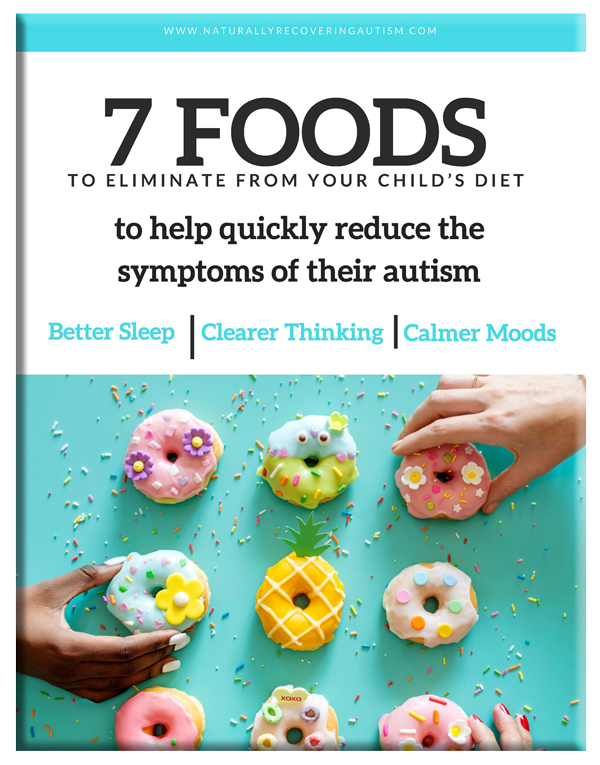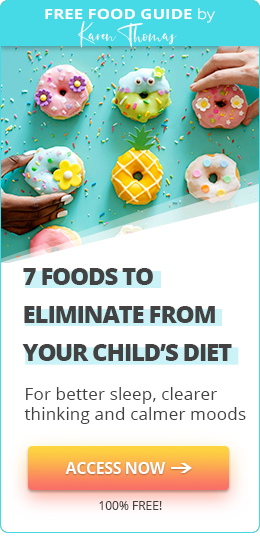Oxalates, salicylates, and phenols may be the culprit of new physical and/or emotional symptoms. They can trigger histamine intolerance and lead to many unwanted symptoms.
A low histamine, low oxalate, low salicylate, low phenol diet along with support for detoxification, including liver support and healing the gut, and balancing candida, are all crucial. There are some enzymes that can help along the way as we work on the underlying root cases, but we need to reduce the amounts of these foods our child is eating, especially if we notice symptoms after eating.

Histamines
Close to 100% of children with autism have histamine intolerance and mast cell activation. Histamines are released by the digestive tract and the brain in defense as an allergic reaction. In histamine intolerance the body is over producing histamines and there are too many for the body to break down. This stress type response is a trigger for mast cell activation which creates a strong inflammatory response in the body.
Symptoms to look for in histamine reactions
Symptoms from histamine triggers are both physical and behavioral. They can vary from itching, hives, rashes, sleep problems, anxiety, extreme mood changes, seizures, digestive issues and diarrhea to increased stimming and more. By reducing stomach acid histamines contribute to further issues with digestion working against your efforts to heal the gut, and is a common reason for GERD or acid back up.
One reaction can happen without all of the others. This can make it hard to determine what the cause is. Try a low histamine diet for a week. If symptoms subside then it can be helpful in determining.
There are also many environmental triggers for histamine release that are far lesser known. A common one is chlorine. We see anxiousness and mast cell activation sometimes after swimming in chlorinated swimming pools. Chlorine is also in tap water so if a sensitive person drinks unfiltered tap water or has a hot shower in chlorinated water and the steam opens the pores then the body absorbs it, as well as inhaling the fumes. A quality water filter is crucial to overall health.
- First, it is crucial to target the root triggers. Eating low histamine foods like organic fresh poultry, grass fed beef, eggs, and line caught fish can be good. Tip: If you give good oils (coconut oil, Extra virgin olive oil) with protein it helps with nutritional absorption and keeps us full longer.
- Avoid high histamine foods like leftovers, especially of animal protein, broths simmered longer than 3.5 hours, beans, corn, fermented foods, avocados, smoked and aged foods, including dried fruit. Tip: freeze leftovers.
- Beware of medications containing additives that are histamine triggers.
Oxalates
Oxalates are in many foods, even healthy ones. They form an organic compound called oxalic acid which is capable of creating oxalate crystals. These crystals can cause health related problems such as kidney stones, and toxicity.
Oxalates are attracted to heavy metals and can trap them in the body to cause toxicity. Oxalates can be found in soy, chocolate, and nuts, as well as other popular health foods like curly kale, spinach, arugula, berries, and broccoli.
Candida overgrowth makes it harder for your body to rid itself of oxalates. An inability to fully digest fat or a diet high in saturated fats can make it harder for your body to get rid of oxalates. Candida makes the problem worse by transforming excessive collagen in the diet into oxalate crystals. These crystals can cause pain.
You can help your body fully eliminate oxalates by:
- Controlling Candida overgrowth.
- Restoring gut health with good bacteria found in probiotics and fermented foods.
- Taking lipase enzymes to help with fat digestion.
- Steaming high-oxalate foods, such as spinach and kale, for as little as 1-2 minutes can remove the oxalates or oxalic acid. Remember to throw out the cooking water because it contains the oxalates.
Symptoms of high oxalates
Oxalates could be a hidden source of headaches, urinary pain, genital irritation, joint, muscle, intestinal or eye pain. Other common oxalate-caused symptoms can also include mood conditions, anxiety, sleep problems, weakness, and burning feet.
What are some foods high in oxalates?
Oxalates are natural compounds found in vegetables, fruits, nuts, and grains. Some examples of foods that are highest in oxalates include green leafy vegetables, soy, almonds, potatoes, tea, cereal grains and beets.
High-oxalate foods include:
- Berries
- Kiwis
- Figs
- Purple grapes
- Potatoes
- Okra
- Beets
- Spinach
- Celery
- Sweet potatoes
- Olives
- Peanuts
- Cashews
- Almonds
- Soy products
- Wheat germ
- Quinoa
- Buckwheat
- Cacao
- Cocoa
- Chocolate
- Tea
____________________________________________________________________________
Salicylates
An additional aspect in food to be aware of are salicylates. These same chemicals in aspirin are found in some plant sources.
The liver processes out salicylates. Since the liver is congested in children with autism it is common for them to have sensitivities.
Symptoms associated with salicylates
When exposed to salicylate, people may experience inflammation in the sinuses and nasal passages, asthma, stuffy nose, breathing difficulties, yeast infections, hives, and lethargy. People with salicylate sensitivity may also report gastrointestinal symptoms, such as diarrhea, nausea and vomiting.
What foods are very high in salicylates?
Foods high in salicylates include legumes such as lentils, and beans. Some vegetables also contain them such as cauliflower, and pickled vegetables. Fruits such as strawberries, plums, watermelons, raspberries also, and some cereals and grains such as buckwheat, oat or corn. Many herbs and spices also contain salicylates.
High-salicylate foods include:
- Tomatoes
- Peppers
- Chilli
- Winter squash
- Broccoli
- Eggplant
- Sweet potatoes
- Cucumber
- Corn
- Spinach
- Dark leafy greens
- Seaweed
- Most herbs and spices
- Avocado
- Apples
- Melon
- Cherries
- Grapefruits
- Watermelon
- Food preservatives
For example, Millet is highly digestible but does contain salicylates which can be ok if your child is not sensitive to them. Watch for symptoms whenever you feed your child anything new. This goes for food or supplements. Medications can also contain them.
______________________________________________________________________
Phenols
Phenols are the natural colorings in foods such as in fruits and vegetables. Phenols are also in the artificial colorings that are in yogurt, candy, and popsicles, etc. Used industrially, they help form and are contained in plastics. They can be an allergen, whether from food or plastic products. People with poor methylation are often phenol sensitive. It is very common for children on the autism spectrum to be allergic to phenols. This is often due to an ill digestive tract.
Normally the body could properly utilize and eliminate phenols. Phenols and salicylates are in most foods. Candida/yeast overgrowth and leaky gut contribute to phenol sensitivity. Leaky gut will allow these chemicals to enter the bloodstream in high concentrations. This alarms the body and triggers an immune response which creates an allergy to these chemicals.
Proteins contain sulfites which turn to sulfates in the body. Sulfates assist with detoxification and digestion. People on the autism spectrum often have trouble digesting proteins, thus causing a deficiency in sulfates. This along with a weakened liver can cause difficulty digesting and eliminating phenolic chemicals.
Phenols are a natural chemical. Salicylates are a type of phenol. They are chemically similar to aspirin. Many people who are phenol sensitive are also allergic to salicylates. These sensitivities create a multitude of physical and behavioral problems.
Phenols are also produced in plants, including fruits and vegetables. The fiber content of fruit, though healthy, may be hard for some to digest also. Spinach and citrus are known to alter the sulphate transport system, or sulfation. This may be the reason why citrus should be avoided within an hour of taking many medications and natural supplementation.
Phenolics are petroleum-based products that are found in plastics, and the dyes in leather goods such as clothing and furniture. They are contained in many health and hygiene products such as toothpastes, hair dyes, disinfectants, and medicines. Phenols are also naturally occurring in many foods. They are very common allergens, especially for a child with autism or one who is sensitive. Phenol sensitivity is common in people with poor methylation, (poor detoxification pathways).
Common symptoms from phenol sensitivity:
- Out of context and unusual laughing
- Erotic moods and behavior
- Eloping
- Night waking
- Constipation
- Diarrhea
- Headaches
- Cravings for phenolic foods
- Red ears
Phenols are in dark vegetables and fruits such as blueberries and apples which also contain a lot of fiber. They are health benefiting foods so, if phenols are a problem, you can use No-Fenol enzymes to help assist in the digestion of phenols while your child’s gut is still healing.
If your child tends to be constipated, the no-phenol enzyme product will help to loosen the stool too. Capsules can be opened up and mixed into any food or beverage. Begin with half the suggested dosage and work your way up.
Quickly Reduce Your Child’s Symptoms
of Autism by Eliminating 7 Specific Foods that Most People Consume Daily!
The first crucial step of autism recovery is to begin restoring health to the gut and the immune system.
The health of the gut is directly linked to the health of the brain and therefore to the symptoms of autism. In fact, 80% of the immune system comes from the gut so if the gut is not healthy, then the brain can’t thrive, and the immune system is compromised. It’s a vicious cycle, but thankfully, it’s one that we can put an end to by first eliminating harmful foods.
This is for informational purposes only and is not meant to diagnose or treat. Every child’s level of recovery is different. No two people are the same. It is never implied that all children will have the same outcome. Results are all based on individual biology and the work that is done. This process takes time and various steps, effort and resources need to be weighed. Our programs are intended to help you become more knowledgeable and guide you to help bring your child a better quality of life, whatever that may be. We want to help by giving great content, direction and strategies that move you forward. Nothing on this page or any of our websites is a promise or guarantee of results or future outcomes. The results on this page and any of our websites are not typical or promised. In fact, there will be people who purchase this and other programs and never put the work into implementing the strategies taught and therefore will achieve little to no results. Our more detailed earnings disclaimer, privacy policy, and terms and conditions for this program and website can be accessed via the links below. We hold ourselves (and you) to a high standard of integrity. We are cheering you on every step of the way.











